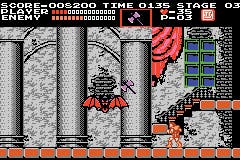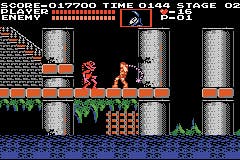Classic NES Series: Castlevania
NES Classic or a reminder of how much things have moved on?
Order yours now from Simply Games.
Considered as one of the all time great gaming series by the determined (and characteristically vocal) hardcore Nintendo throng, and for good reason after it firmly established itself among 16-bit gamers in the 90s with a series of quite stunningly well-realised whip-cracking platformers that are still gaining admirers thanks to the GBA. Its star may have fallen in recent years with the mainstream home console audience after some fairly insipid attempts to move the series into 3D (none have even coming close to making an impact in the charts in Europe, tellingly), but continued interest in the 2D handheld incarnations (including a newly announced Castlevania for the DS) have generated just enough interest to justify raiding the archives with this mid-priced re-issue. Finally the series aficionados can trace the game way back to its NES origins and see how it fairs in today's market. How kind time has been to the 8-bit version we were intrigued to find out, but we weren't expecting miracles.
In the first of the many Castlevania outings you control a whip-cracking vampire slayer by the name of Simon Belmont. A man on a mission to crack said whip against a whole castle full of deadly minions - giant bats, mummies, and assorted sentries, ghosts, and of course hideous bile spewing boss monsters, not to mention the prince of darkness Dracula himself - to present the kind of platform-centric title that would have been considered "challenging" even back in its own era, never mind in this more forgiving period of gaming.
Dracu-like

As you'd perhaps expect, this is something of case study in fascist 8-bit side-scrolling platform-o-doom, that's was designed around the now-archaic principle that being incredibly challenging equalled gaming fun for all the family. The trouble was, only the most determined, skilled and patient gamers that ever lived could reasonably be expected to extract the entertainment provided. But to give Konami its dues, back in those days this kind of game design was basically par for the course and you simply knew you were in for a rough ride from the word go, and cut your cloth accordingly.
Fast forward eighteen years into a far less demanding era, where a broader, less skilful, less patient type of gamer expects to be effectively molly-coddled through most games, and something as extreme as Castlevania has numerous design issues that stand out like a beef burger in a Vegan restaurant. Castlevania certainly doesn't pull its punches with death practically omnipresent every half a screen, but this ought not to come as a huge surprise to most of us of a "certain age". European-based gamers, especially, who grew up in the early 80s will bitterly recall that even the most well-rated titles of that era were just plain hard work - even then.
Plucking a few epics out of the air at random such as Ultimate's classic UnderWurlde, and Odin's Nodes Of Yesod, and it was standard practice to offer limited lives, no continues, no save points, no checkpoints and in most cases not even so much as armour or an energy bar to fall back on. It was instant death all the way; and to complete games back then was feat of almost superhuman endurance. Castlevania has at least tempered the difficulty level with a few now-standard innovations, like an energy bar and a continue system. Added presumably to limit the frustration factor we even have a save system (which was absent from the NES original). But even with these welcome additions, for those of you that aren't well versed in the intense demands of games of this era you're still looking at a game that demands much repetition, precision jumping, unresponsive controls and a less than useful combat system.
When computers ruled

Having missed out on the first generation of Nintendo hardware (largely as a result of them having a very limited presence in the UK in the '80s when it was all about Commodore, Sinclair, Amstrad and Atari) this was actually this reviewer's first ever incursion into the first Castlevania, and having sunk countless hours into it over the Christmas period, it's definitely the sort of game that will have even the most skilful retro-versed gamer screaming with rage within minutes. Every room is destined to have at least a few moments of life-sapping death lurking in it somewhere, and only sheer iron will and persistence will give you the faintest hope of getting very far.
Preparing for a thousand ways to dodge death is the name of the game. If you're not having your balls busted by some flying cretin leaping and swooping to meet your path, the chances are they'll pop out of nowhere and simply knock you to instant death instead. Annoyingly this usually means right back to the beginning of the game's current section, which could be four or more screens back. Repetition isn't so much of a problem until you inevitably meet a boss monster at the end of every third level, and at least for the first few occasions, that's a given. Your undoubted death at a boss stage forces you back three levels (about a dozen screen's worth of careful negotiation) with no progression possible until such a time as you're good enough to suss out the boss, in just one example of spirit-crushing game design.
Visually Castlevania's not something that's especially offensive, but neither was it ahead of its time. It doesn't help much that unlike the SNES, the NES wasn't an outstanding piece of technology even when it was released; it just did the job. It's pretty much exactly as you'd expect for an early-ish NES title with blocky, indistinct sprites with hardly any animation to speak of and predictably evil attack patterns that give the player very limited room to manoeuvre. Like most games of the era, every room is built with a series of platforms, mainly on a split level but never scrolling upwards. It's simple left to right (and vice versa) with the odd limited weapon upgrade (such as throwing stars, magic potions, throwing daggers and so on), and platforming that's about as basic and straightforward as it comes. Some might argue that it's got a seminal quality, but they're almost certainly recalling cherished personal memories. Nostalgia is a hard thing to argue with; until you revisit it.
Retro gaming at today's prices
The harsh truth is there were an enormous number of platform games of this wonderful era that we'd rather revisit; it's just most of the associated brands didn't live beyond the 8-bit era. Even back in 1986 demonstrably unfair progression systems were rife, so to a large extent you do have to take this kind of constant backtracking on the chin. But if any game dared appear like this today it would have no place in gaming. When we'd normally judge retro games they'd be comparatively so cheap to make a lot of the complaints ill-judged, but in our opinion when you're being asked to pay good money for something, you'd be foolish to consider Castlevania's merits in anything other than the harsh light of 2005. If you know what you're paying for, and know all about the original then fair enough, but otherwise don't say we didn't warn you.
As an example of typical 8-bit platforming, Castlevania is probably not all that representative. As a history lesson in how the series was originally conceived it's an interesting case study in how things used to be, but not all games were this evil - some were even more evil! We still suggest that arch Castlevania fiends check it out if they feel compelled to complete their collections, as once you get into the groove there is a degree of enjoyment to be had, but at least try it before you buy if you can. For anyone else, we recommend you do something less stressful. Like gardening. Or vampire hunting.

